
BIOS and Overclocking …
Get fast to the right UEFI settings …
ASRock X399 Taichi BIOS and Overclocking
ASRock X399 Taichi UEFI BIOS Update
ASRock X399 Taichi overclocking
ASRock X399 Taichi memory settings
ASRock X399 Taichi voltage settings
ASRock X399 Taichi Overclock even easier
ASRock X399 Taichi BIOS undervolting
ASRock X399 Taichi Fan control
BIOS and overclocking …
Let us continue with the BIOS / UEFI Setup options and the UEFI overclocking. By pressing F2 or Del during PC boot, you get access to the UEFI Setup.
The ASRock X399 Taichi UEFI has a graphical interface that allows intuitive operation with the mouse, or can be operated still as usual with a keyboard.
In contrast to the AMD Ryzen AM4 motherboards, the ASRock TR4 motherboards again are equipped with the well-known ASRock EZ mode – Easy Mode, which offers a clear input page with a lot of important information and still does not seem overloaded. Basic information such as time, date, CPU temperature, motherboard temperature, CPU voltage, first details about hardware, fan speed, hard disk configuration, RAID mode and fan settings are done with one click.
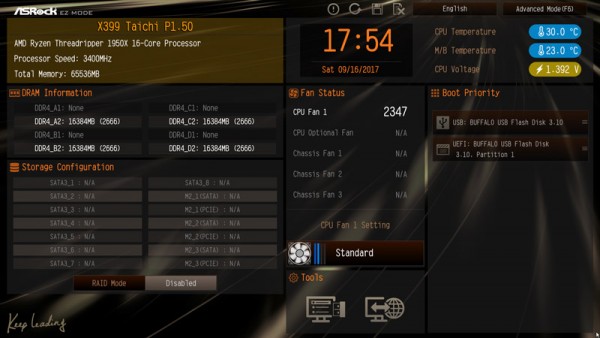
In addition, a few applications have been combined in one tools page.
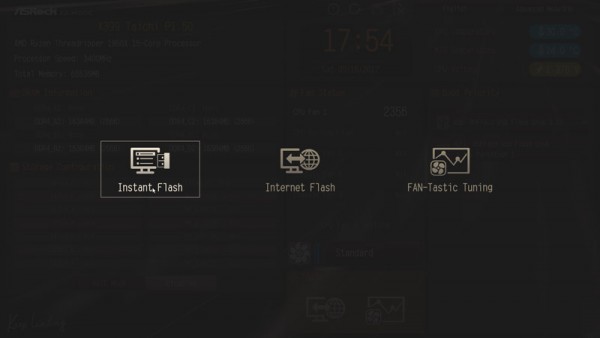
Of course you can also use the EZ menu to set the time and date again.
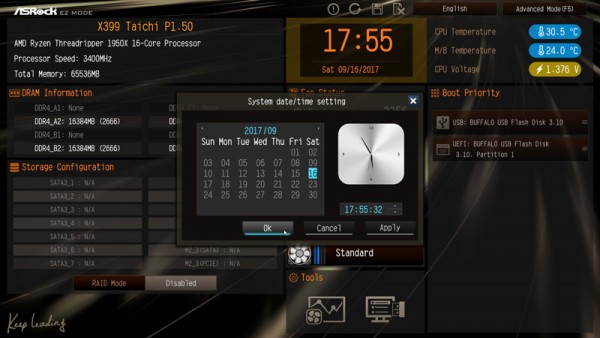
Many functions can be controlled with the following shortcuts or F-keys.
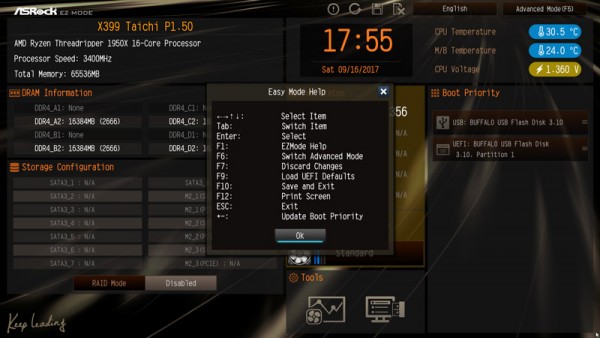
With the F6 key or the upper right button you get to the usual ASRock Advanced Mode, which you can also set as default. Overclocker will probably start with Advanced Mode or directly with the Tweaker or Favorite menu anyway, but later more about that.
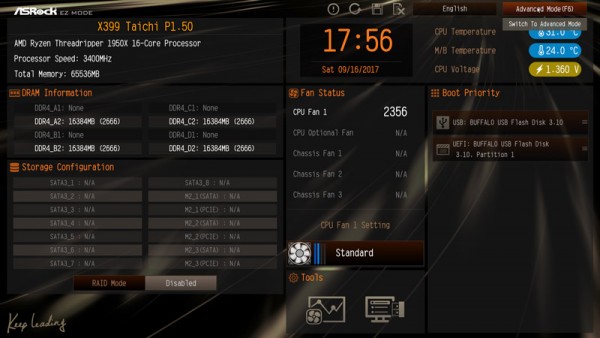
The system browser view, the ASRock Tech Service and the My Favorite menu item is (not yet?) available on the ASRock X399 mainboard, but you can find the Full HD UEFI selection and the Active Page on Entry selection again, which allows you to decide on which UEFI page you want to start with in the UEFI setup. This is especially helpful for overclocking, as you often have to go to the second OC-Tweaker menu to find the optimal OC settings. On the ASRock X399 Taichi you will find the Active Page on Entry option and the Full HD UEFI selection under Advanced.
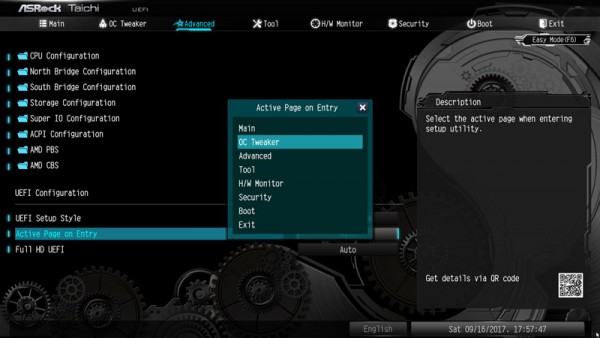
UEFI BIOS Update …
Before we start with the UEFI overclocking possibilities, we first update the UEFI BIOS to the latest version. Since ASRock regularly adds new features, better memory support and new processors, the BIOS update is recommended in most cases. ASRock offers several possibilities for flashing the UEFI update, e.g. the very simple Instant Flash or even the ASRock Internet Flash with a direct connection to the internet. The ASRock Instant Flash Utility can be accessed via the ASRock Instant Flash Option in the Tool Screen or via the F6 key at PC startup. You can simply install a previously downloaded ASRock BIOS without boot CD or similar by starting the ASRock Instant Flash Utility. Then select the BIOS Flash ROM from the drive you want to use, e.g. from a USB stick, which you have to unpack after downloading.
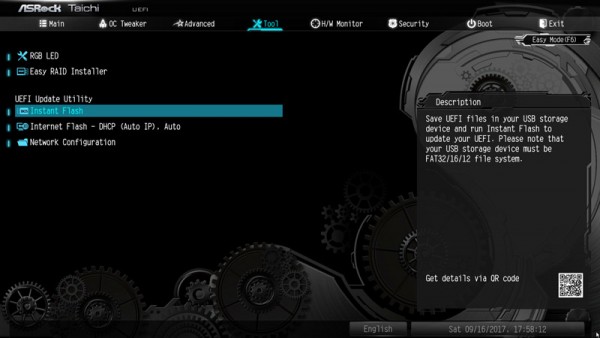
This time we use a different option and that’s the ASRock BIOS Flashback Switch, which we already mentioned in our ASRock X399 Video. You can transfer the BIOS without CPU, memory and graphics card from the USB stick to the motherboard and can even update with an old BIOS to a new CPU. You load the latest BIOS file into the main path on a FAT32 formatted USB stick and rename it as creative.rom. At the time of testing, the latest UEFI BIOS version P1.50 was available for download. The USB stick is then plugged into the lower USB 3.0 port between the sound port and the LAN port. This is important because the BIOS update only works with this USB port. Now press the BIOS flashback switch for about 3 seconds and start the BIOS update (recognizable by the green LED flashing in the BIOS flashback button). As soon as the LED stops flashing, the BIOS has been updated.
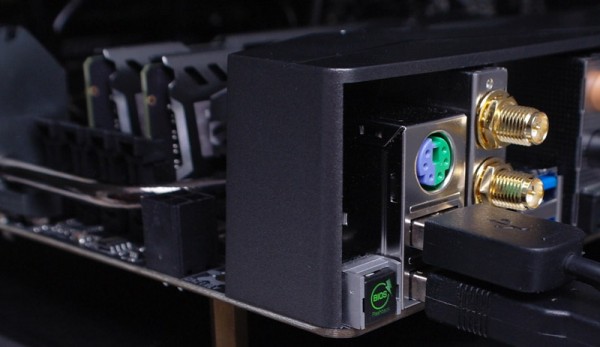
The new UEFI version is available after the mainboard has been fully loaded and can be checked directly on the input side, as you can see here with the AMD Ryzen Threadripper 1950X CPU.
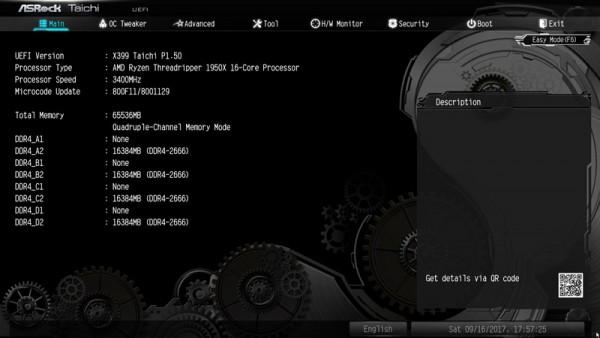
The RGB LED entry is located on the Tools page.
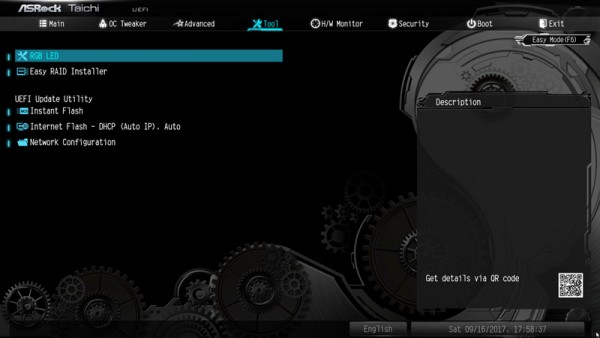
In the ASRock RGB LED menu of the Z270 series it is possible to do all RGB LED settings already in the UEFI. Not so with the ASRock AMD motherboards. At least at the time of testing, there is a selection for activation and deactivation as well as adjustment of the lighting.
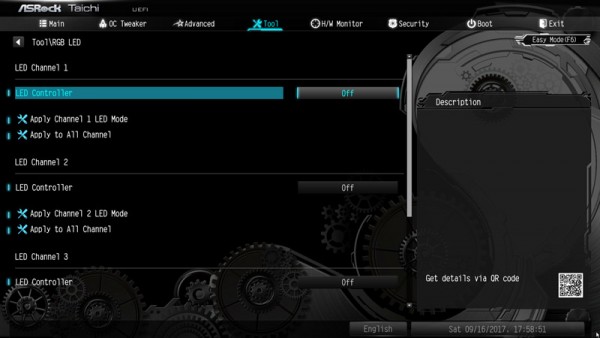
The RGB LED settings are not displayed graphically, but are also available in the UEFI. More easy and beautiful is the ASRock RGB LED software in Windows (as shown on the previous page of the test).
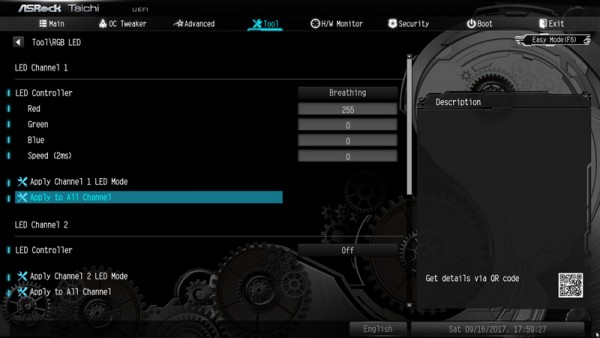
Although ASRock does not offer an Easy Driver Installer option for the X399 motherboard (yet?), ASRock makes the RAID driver installation very easy for the user by offering with the Easy RAID Installer the easy way to download the current RAID drivers.
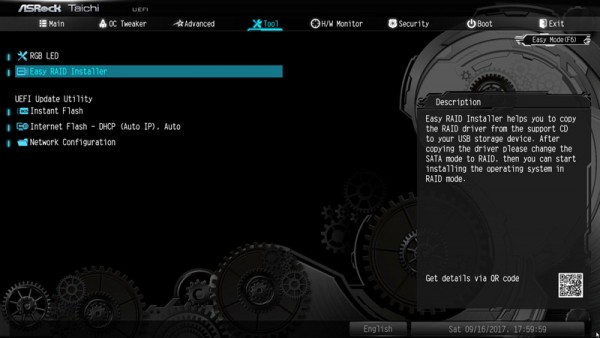
ASRock X399 Taichi overclocking …
Now let’s get to AMD Ryzen Threadripper overclocking with the X399 chipset on the ASRock X399 Taichi motherboard. ASRock split the OC-Tweaker settings for this ASRock X399 Taichi in CPU Configuration, DRAM Configuration and Voltage Configuration. These are summarized on a single page to remain easy to manage.
Let’s start at the top – once to the overclock mode is set from auto to manual …
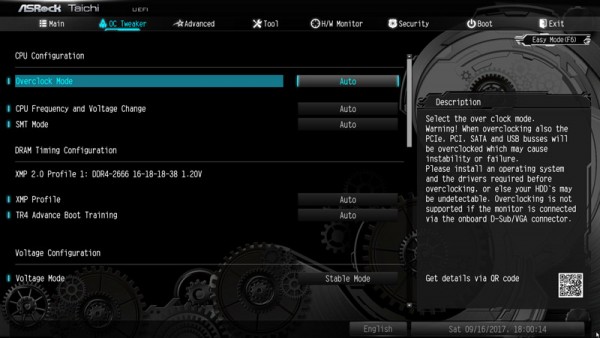
… the APU/PCIE frequency setting is available.
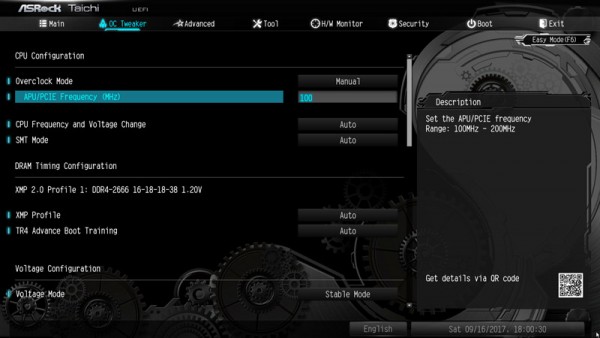
Thanks to the extra Hyper BCLK Engine II clock generator the BCLK/PCIE frequency is available from 100 MHz up to 200 MHz. This frequency is very important for a lot of frequency values also with AMD Ryzen Threadripper processors, which can get quickly too high. For this reason, you should carefully increase the BCLK host clock, for example for RAM overclocking.
In our tests the board could be overclocked to 108 MHz.
In CPU configuration at manual selection there are two more important OC options for AMD TR4 CPU Overclocking: CPU frequency and CPU voltage, but more on that later at the voltages.
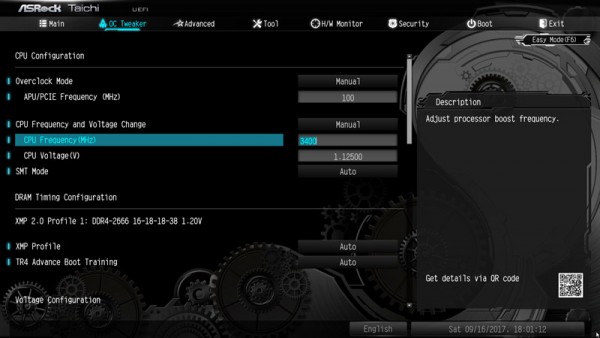
AMD Ryzen Threadripper processors have an unlocked multiplier so that you easily can increase the CPU frequency. With the AMD Ryzen Threadripper 1950X CPU (default clock 3400 MHz at a CPU ratio of 34x) the ASRock X399 Taichi motherboard offers a range from 2400 MHz up to 6300 MHz without raising the bus frequency.
How easy it is, we tried summarily with the AMD Ryzen Threadripper 1950X CPU and with highly increased VCore – as reported in our AMD OC Forum under AMD Ryzen Threadripper 1950X OC – from 3400 MHz on approx. 4200 MHz. Although not prime stable, but you can see, how high the TR4 CPUs can be overclocked. Here you can see the confirmed CPU-Z Tool with 4115.18 MHz at 1.408 Volt.
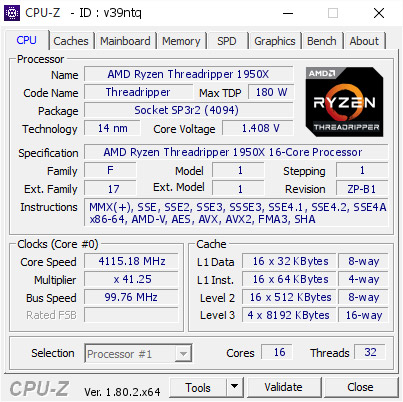
ASRock X399 Taichi memory settings …
Thanks to XMP support, XMP memory modules can be set correctly with one mouse click in the UEFI.
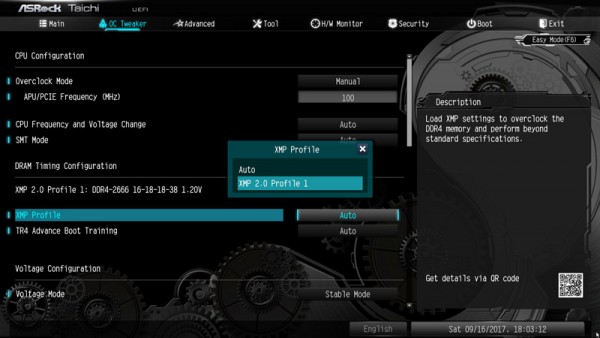
Alternatively, you can select the values manually. In the BIOS version P1.50 there is no DRAM configuration menu yet. Therefore you can find all important memory settings under Advanced -> AMD CBS -> UMC Common Options -> DRAM Timing Configuration. Unfortunately, this is rather awkward and has to be confirmed.
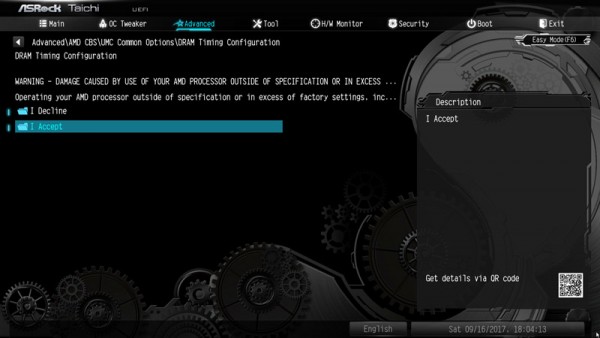
With the DDR4 memory clock, you can select values from DDR4-333 to DDR4-3600, for example. Thanks to the ICS Hyper BCLK Engine II clock generator chips, it is possible to increase the BCLK/PCIE frequency and thus at least theoretically select a DDR4 memory clock up to DDR4-6400.
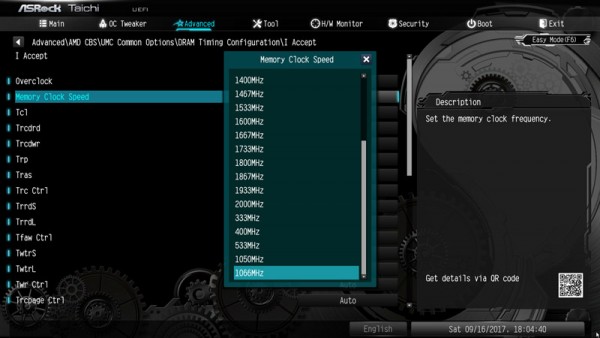
Optionally you can manually adjust all DDR4 timings.
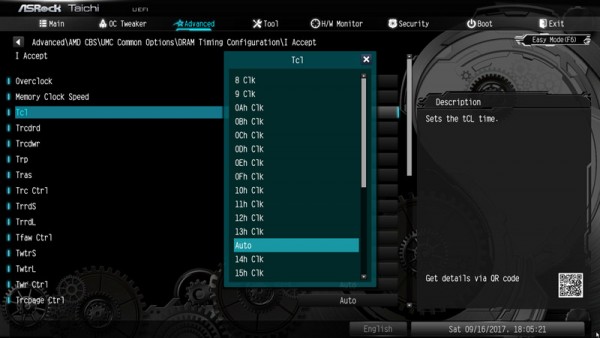
ASRock X399 Taichi voltage settings …
Now we come to the voltage settings that can be adjusted in the UEFI.
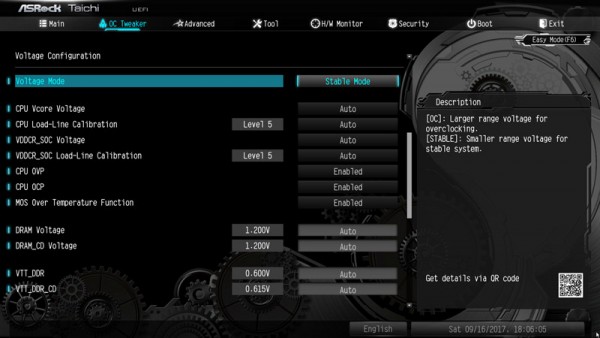
A very important point in the OC Tweaker BIOS is the choice between the stable mode and OC voltage mode – after changing to OC mode, significantly higher voltages are available!
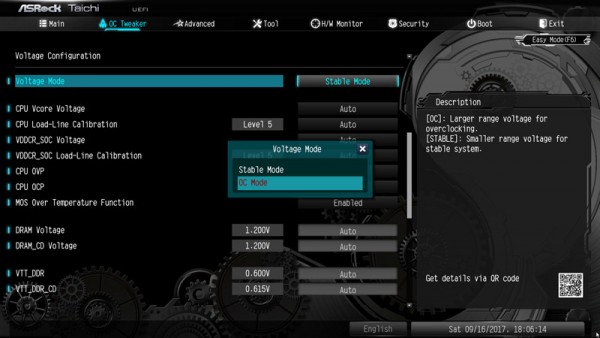
CPU Core voltage can be set to fixed or offset value.
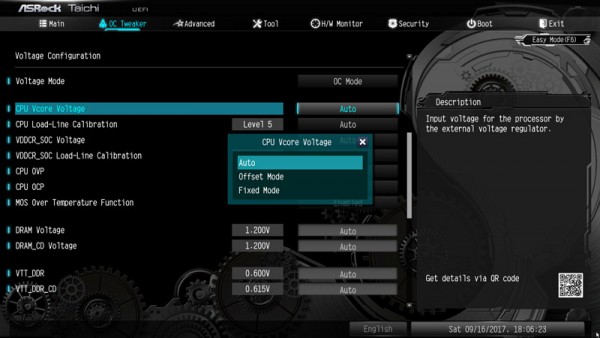
With fixed in OC mode for the AMD Ryzen Threadripper 1950X test CPU a VCore can be adjusted up to 2.50000V! This is of course much too high, but nevertheless LN2 overclockers will enjoy. Furthermore, the X399 motherboard has numerous voltage settings such as VTT_DDR, VDDCR_SOC, VPPM Voltage, 2.50V PROM Voltage, +1.8V Voltage, +1.8V SB Voltage, CPU Load Line Calibration and more, which makes it possible to overclock the AMD Ryzen Threadripper CPU very well.
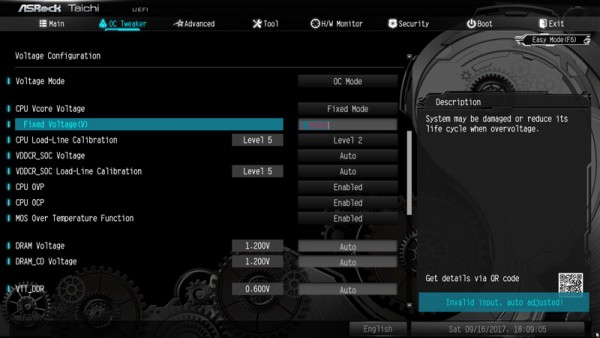
The DDR4 voltage can be increased between 1.100 and 2.235V for high DDR4 memory overclocking or undervolting.
ASRock X399 Taichi easy overclocking …
Who rather would like to overclock in Windows, can make many of the above voltage and frequency settings even with the ASRock A-Tuning tool or as shown in the soon published AMD Ryzen Threadripper OC guide you can also overclock with the AMD Ryzen Master Threadripper Tool.
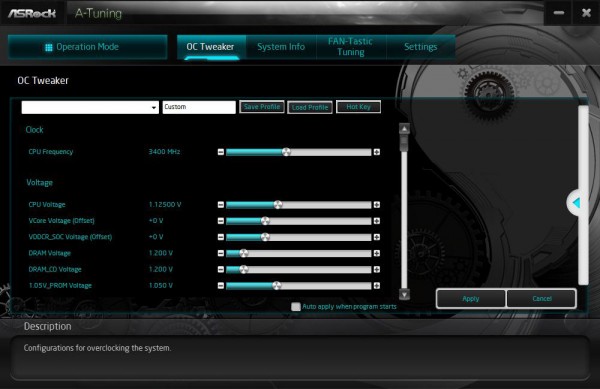
Once the desired settings are found, you can save up to five different OC Tweaker BIOS settings with names in the UEFI.
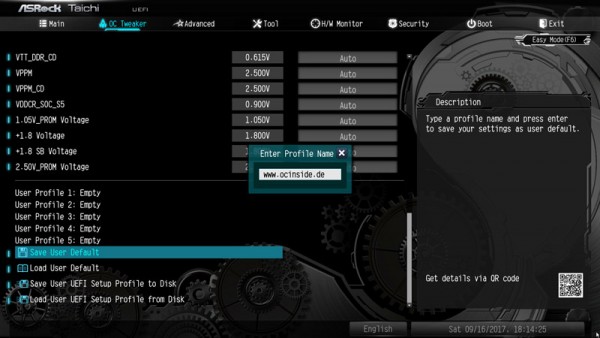
For example, you can save balanced BIOS settings, overclocking settings and undervolting settings or Office and Gaming settings in an user profile of the UEFI to load them very quickly at any time.
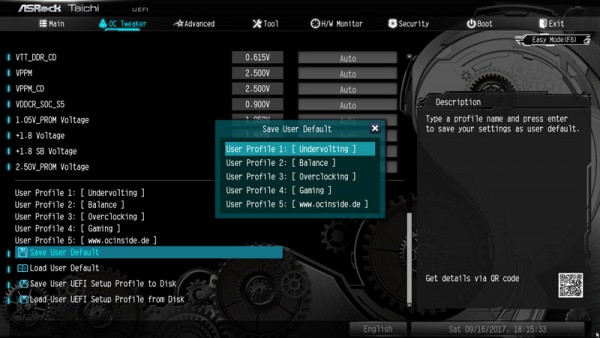
Also interesting is the Save User UEFI Setup Profile to Disk option. Just click it to save your own UEFI settings on the hard drive or an USB stick.
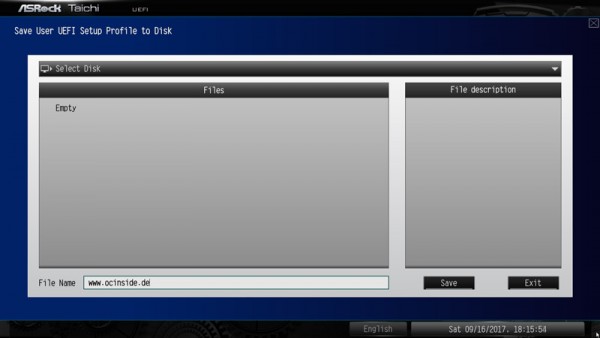
BIOS Undervolting …
The downclocking or underclocking is also tested in this review. It was possible to lower the AMD Ryzen Threadripper 1950X CPU frequency down to approx. 3200 MHz. Of course, underclocking is like overclocking outside of the manufacturers specification, so it is necessary to have some luck. ASRock gives several options for easy PC underclocking / downclocking.
Very hidden is also at this X399 board the P-states setting, which is very interesting for AMD Ryzen Threadripper optimization.
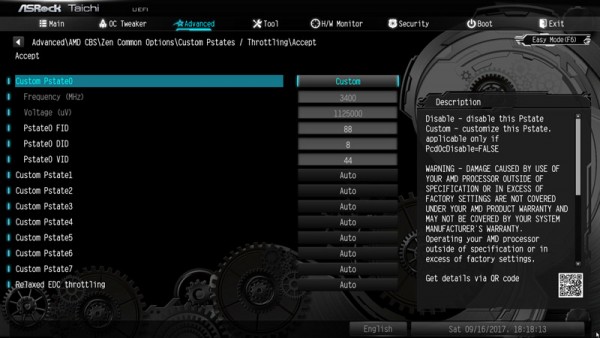
Under Advanced -> AMD CBS -> Zen Common Options you will also find predefined OC Mode Pstates settings for direct selection.
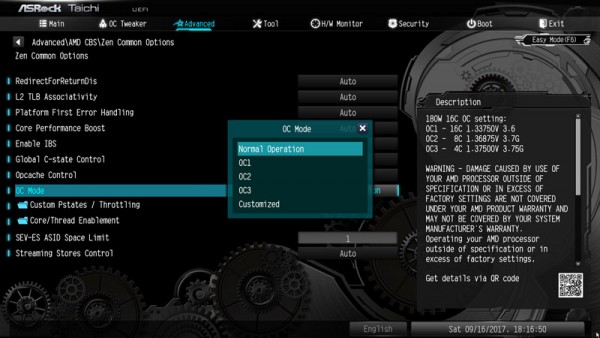
Of course there are more UEFI settings like CPU Configuration, North Bridge Configuration, South Bridge Configuration, Storage Configuration, Super IO Configuration, ACPI Configuration, AMD PBS menus and the AMD CBS menus.
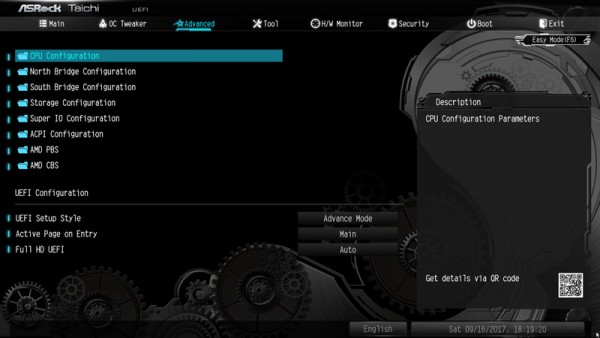
New are mainly the AMD Ryzen Threadripper settings in the AMD CBS sub-menu, where you can set the previously mentioned Custom Core PStates in Zen common options.
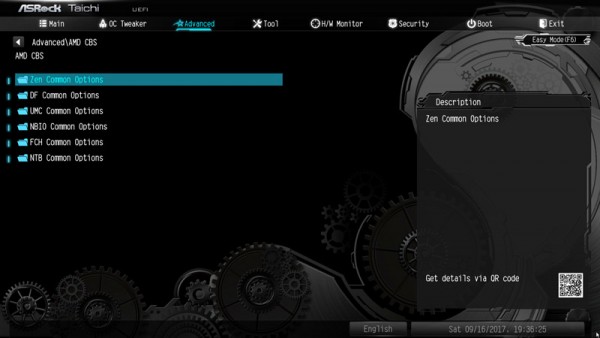
Under Advanced -> AMD CBS -> FCH Common Options -> XGBE Configuration Options you can find the LAN ports.
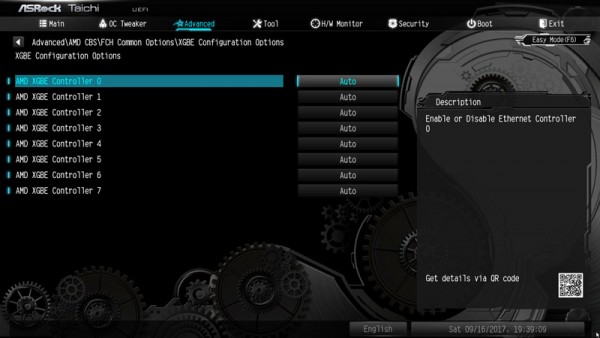
At this point we hope a better overview in order to make all the important settings as usual – whether they are physically in the Northbride, Southbridge or in any other chip on the motherboard is not interesting for most users.
But we know ASRock and think it will soon give a BIOS update, which makes such basic settings much easier to find … may be they could do this by an additional search function in the UEFI, which we as OCinside would like to suggest again 😉
Fan control …
The UEFI Setup of the passive cooled X399 Taichi motherboard offers extensive temperature fan control options. The settings for the fan controller can be found in H/W Monitor directly below the temperature and voltage display.
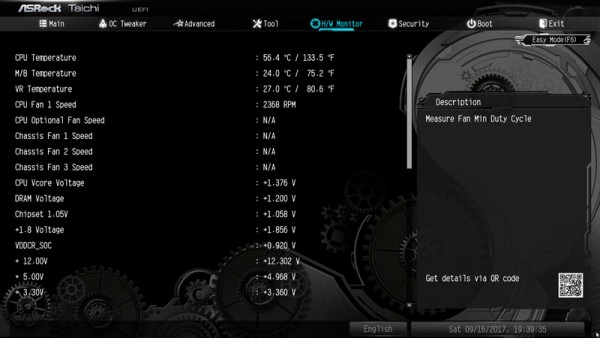
Here are settings for the CPU fan, chassis fans or W_Pump switch.
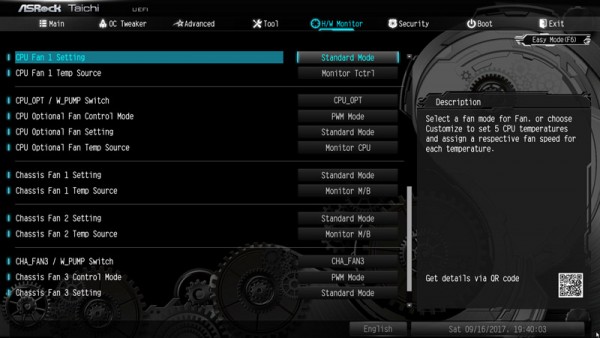
You have the choice between Customize, Silent, Standard, Performance and Full Speed.
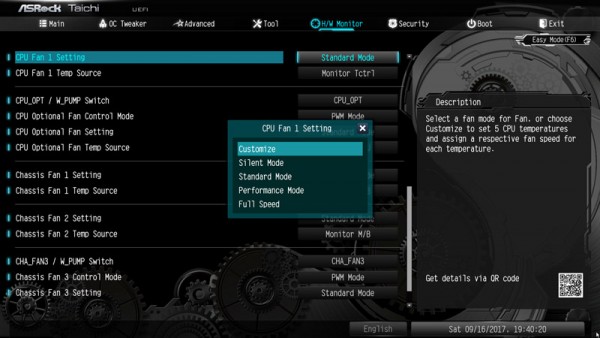
In Customize mode there are several temperature steps available to assign a certain fan speed.
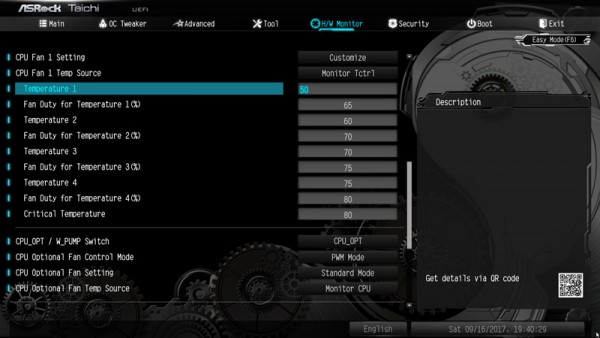
ASRock has again implemented the graphical interface in the UEFI setup for controlling the fans. You can find the FAN-Tastic Tuning menu also in the H/W monitor and thus can make all the settings very clearly. Simply select the respective fan connector on the left and select the mode on the right side: Silent, Standard, Performance or Full Speed.
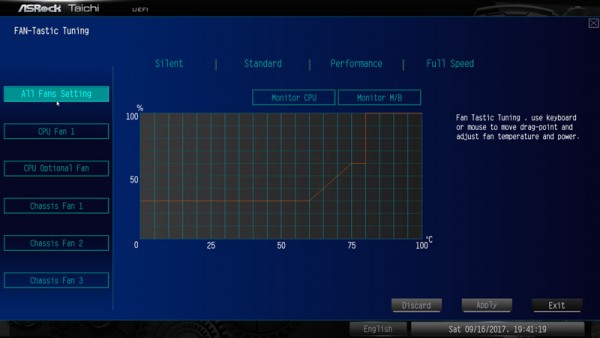
In Customize mode, you can set all values directly in the chart and save.
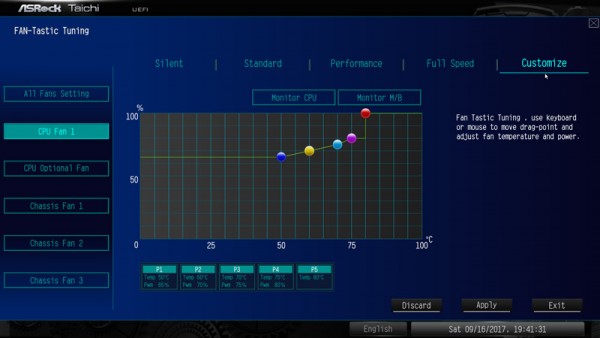
For the chassis fan connectors you can even select, which source you want to use for temperature measurement – Monitor CPU or Monitor Motherboard. Then click on apply and save the values.
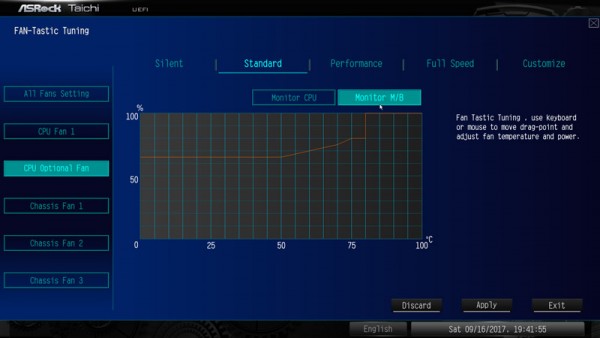
And even the control of the 3-pin chassis fans was thought with the DC/PWM mode switch.
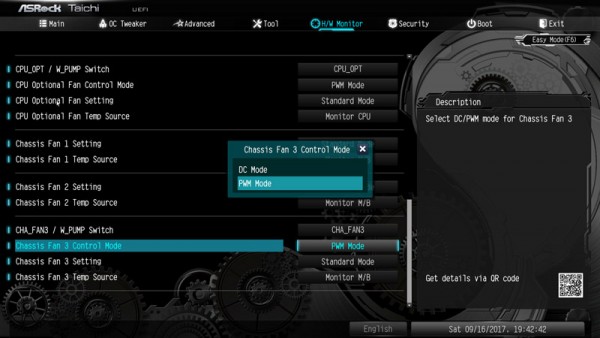
Who would rather set the values in Windows, you can use also the ASRock A-Tuning tool.
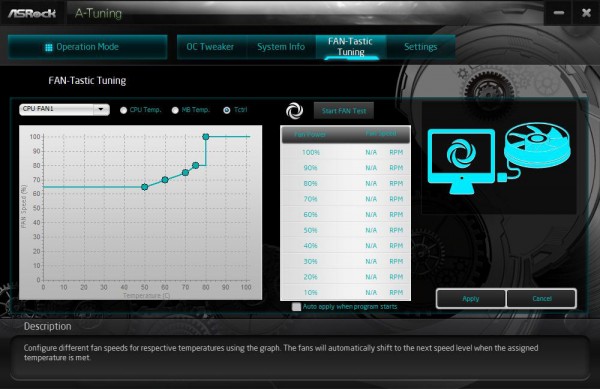
You can usually get along without an expensive Fan Controller, because the fans are controlled with this fan control based on CPU or motherboard temperature.
ASRock X399 Taichi energy consumption …

